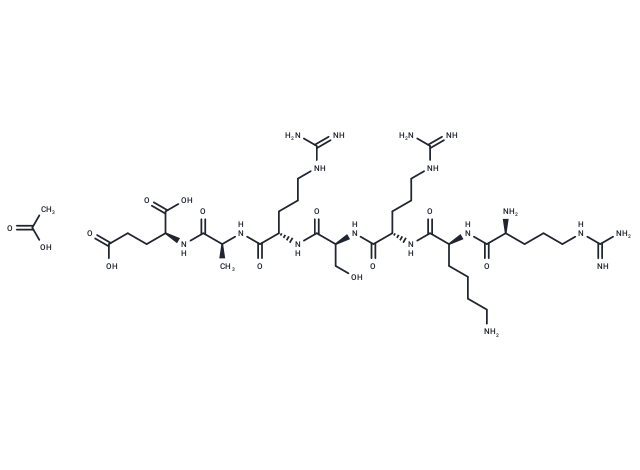Shopping Cart
- Remove All
 Your shopping cart is currently empty
Your shopping cart is currently empty

PKG Substrate acetate is a selective substrate for cGMP-dependent protein kinase (PKG).PKG Substrate is a selective substrate for protein kinase G (PKG) with a strong preference for PKG Iα (Km = 59 μM) over PKG II (Km = 305 μM).

| Pack Size | Price | Availability | Quantity |
|---|---|---|---|
| 1 mg | $61 | In Stock | |
| 5 mg | $220 | In Stock | |
| 10 mg | $329 | In Stock | |
| 25 mg | $532 | In Stock | |
| 50 mg | $713 | In Stock | |
| 100 mg | $978 | In Stock | |
| 200 mg | $1,290 | In Stock |
| Description | PKG Substrate acetate is a selective substrate for cGMP-dependent protein kinase (PKG).PKG Substrate is a selective substrate for protein kinase G (PKG) with a strong preference for PKG Iα (Km = 59 μM) over PKG II (Km = 305 μM). |
| In vitro | Incorporation of [33P]ATP into the synthetic peptide PKG substrate RKRSRAE is measured. N6-benzyl-ATP inhibits kinase activity of PKG Iα gatekeeper mutants but not WT. The serotonin transporter (SERT) is responsible for reuptake of serotonin (5-hydroxytryptamine) after its exocytotic release from neurons. SERT is regulated by several processes, including a cyclic GMP signaling pathway involving nitric oxide synthase, guanylyl cyclase, and PKG[1]. |
| Molecular Weight | 962.08 |
| Formula | C37H71N17O13 |
| Smiles | CC(O)=O.O=C(O)CC[C@@H](C(O)=O)NC([C@H](C)NC([C@H](CCCNC(N)=N)NC([C@H](CO)NC([C@H](CCCNC(N)=N)NC([C@H](CCCCN)NC([C@H](CCCNC(N)=N)N)=O)=O)=O)=O)=O)=O |
| Relative Density. | no data available |
| Storage | keep away from moisture | Powder: -20°C for 3 years | In solvent: -80°C for 1 year | Shipping with blue ice. |

Copyright © 2015-2025 TargetMol Chemicals Inc. All Rights Reserved.